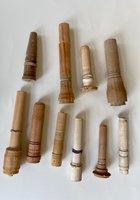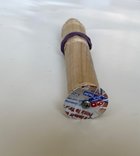This technique is applicable to tall objects such as vases where the inside diameter of the bottom is equal to or smaller than the inside diameter of the neck. I have only used it for small objects under about 10 inches in length, but it may be practical for larger pieces. The figure shows an example of a small vase and the jig used to turn its bottom. The jig consists of a cylinder with a tenon on one end, if required for chucking, and the other end trimmed to fit snugly inside bottom of the piece. The portion near the neck of the piece is trimmed to a loose fit. A shallow notch is turned just inside the smallest point of the neck and a coiled rubber band is forced into the notch to form a grommet. The depth of the notch and the size or number of rubber bands is adjusted until the jig can can be twisted with some effort through the neck of the piece.




